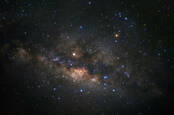This article is more than 1 year old
Kepler may be dead but its data keeps on giving, thanks to AI: Two alien worlds found in archives
Physics undergrad tells El Reg how she developed planet-spotting machine-learning code
Machine-learning algorithms have been used to uncover two previously unseen exoplanets in the archive of data amassed by NASA’s retired Kepler space telescope.
Launched in 2009, Kepler was sent to survey the dark reaches of the Milky Way. Its job was to hunt for alien worlds by scrutinizing the light emitted by faraway stars. Armed with a photometer, Kepler looked out for the characteristic dip in brightness as a planet crossed in front of its parent star. It was retired last October.
The spacecraft has helped scientists discover more than 2,000 distant planets, and there are still many to be found yet. A team of astronomers and engineers, led by the University of Texas, Austin, and Google, worked together to sniff out potential candidate exoplanets using a convolutional neural network. This software was trained using a dataset of stars and planets observed by Kepler, so that when looking at readings of other stars' brightness, it could predict the presence of an alien planet for each of them.
Two previously unknown worlds were found by the neural network, as it chugged through Kepler data looking for signs of orbiting planets, and their existence has been confirmed using telescopes in Arizona and Hawaii in the US. Christened K2-293b and K2-294b, both bodies are close to one another, and are located 1,300 light years and 1,230 light years away in the constellation Aquarius, respectively, and they’re both slightly bigger and hotter than Earth. The full findings will be published in the next edition of The Astrophysical Journal (here's a free version of the writeup).
Thrust of the matter
The data revealing the pair of planets came from Kepler’s K2 phase of its mission. In 2013, two of the spacecraft’s four reaction wheels broke down and it could no longer stay pointed at a particular star, so NASA reconfigured it so that its thrusters and the other remaining wheels could hold it steady in place.
Dealing with K2 data has been trickier, Anne Dattilo, an undergraduate physics student at the University of Texas, Austin, explained to The Register. The team had to account for a slight wobble and systematic noise in the spacecraft’s readings.
“I trained my modified algorithm using data from over 27,000 stars from K2," she said. "It only took 40 minutes to train on my laptop successfully, but months for us to figure out how to make it work on K2 data successfully.”
The convolutional neural network was trained to look for periodic dips in a star’s light brightness over time, which would suggest the passing of a planet. Since it was only trained using examples of stars that have nearby planets, it won’t catch all the different types of exoplanets, such as suns that have far-flung worlds.

It was the best of times, it was the WFIRST of times: How NASA's next exoplanet hunter could find 1,000+ worlds
READ MORE“The algorithm missed 'special' planets: those whose signals had different shape than the run-of-the-mill planets," said Dattilo. "Disintegrating planets are one example, these planets have different shaped transits than 'typical' planets. This means that there is still a need for human astronomers to find the more interesting planets,” Dattilo said.
Despite this, however, Dattilo believed that neural networks will still be useful in finding new planets spied by NASA’s TESS space telescope. The spacecraft was launched into the heavens last year, and is expected to discover tens of thousands of exoplanets over two years.
“The same method should be applicable to TESS in the future because TESS works the same way that Kepler and K2 did- they measure the change in brightness of stars," said Dattilo. "However, I suspect several changes would need to be made. I made changes for the Kepler to K2 code, and TESS data is very different than Kepler or K2 data because it looks at the stars for a shorter period of time.”
It's not the first time AI helped scientists find new worlds. Last year, a similar team of researchers using machine learning stumbled across the eighth planet orbiting the Kepler-90 star that was previously missed. The finding made Kepler-90 the only other planetary system to have eight planets like our own Solar System, well, that we've seen. ®
